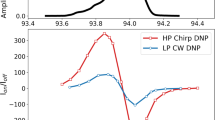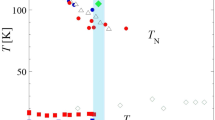Abstract
MEASUREMENTS of radio-frequency absorption and dispersion due to nuclear magnetic resonance have been made at liquid hydrogen temperatures using the same experimental arrangement as described in a recent note1. We have observed very strong resonant effects due to the protons in liquid and solid hydrogen. On account of the increased Boltzmann factor, the signals were considerably greater than those obtained with substances at room temperature, and were several thousand times the noise voltage. There appeared to be no appreciable change in the phenomena on solidification of the hydrogen. In agreement with the conclusions of Lasarew and Schubnikow2 from their experiments on the susceptibility of solid hydrogen, we find the relaxation time for nuclear orientation to be less than one second. The absorption line was very sharp, and we estimate the width to be less than 0.5 gauss (2 kc./sec.).
This is a preview of subscription content, access via your institution
Access options
Subscribe to this journal
Receive 51 print issues and online access
$199.00 per year
only $3.90 per issue
Buy this article
- Purchase on Springer Link
- Instant access to full article PDF
Prices may be subject to local taxes which are calculated during checkout
Similar content being viewed by others
References
Rollin, B. V., Nature, 158, 669 (1946).
Lasarew, B. G., and Schubnikow, L. W., Phys. Z. Sowjetunion, 11, 445 (1937).
Author information
Authors and Affiliations
Rights and permissions
About this article
Cite this article
ROLLIN, B., HATTON, J. Nuclear Magnetic Resonance at Low Temperatures. Nature 159, 201 (1947). https://doi.org/10.1038/159201a0
Published:
Issue Date:
DOI: https://doi.org/10.1038/159201a0
This article is cited by
-
Quelques problèmes actuels du paramagnétisme
Experientia (1948)
-
Nuclear Magnetic Resonance at Low Temperatures
Nature (1947)
Comments
By submitting a comment you agree to abide by our Terms and Community Guidelines. If you find something abusive or that does not comply with our terms or guidelines please flag it as inappropriate.



